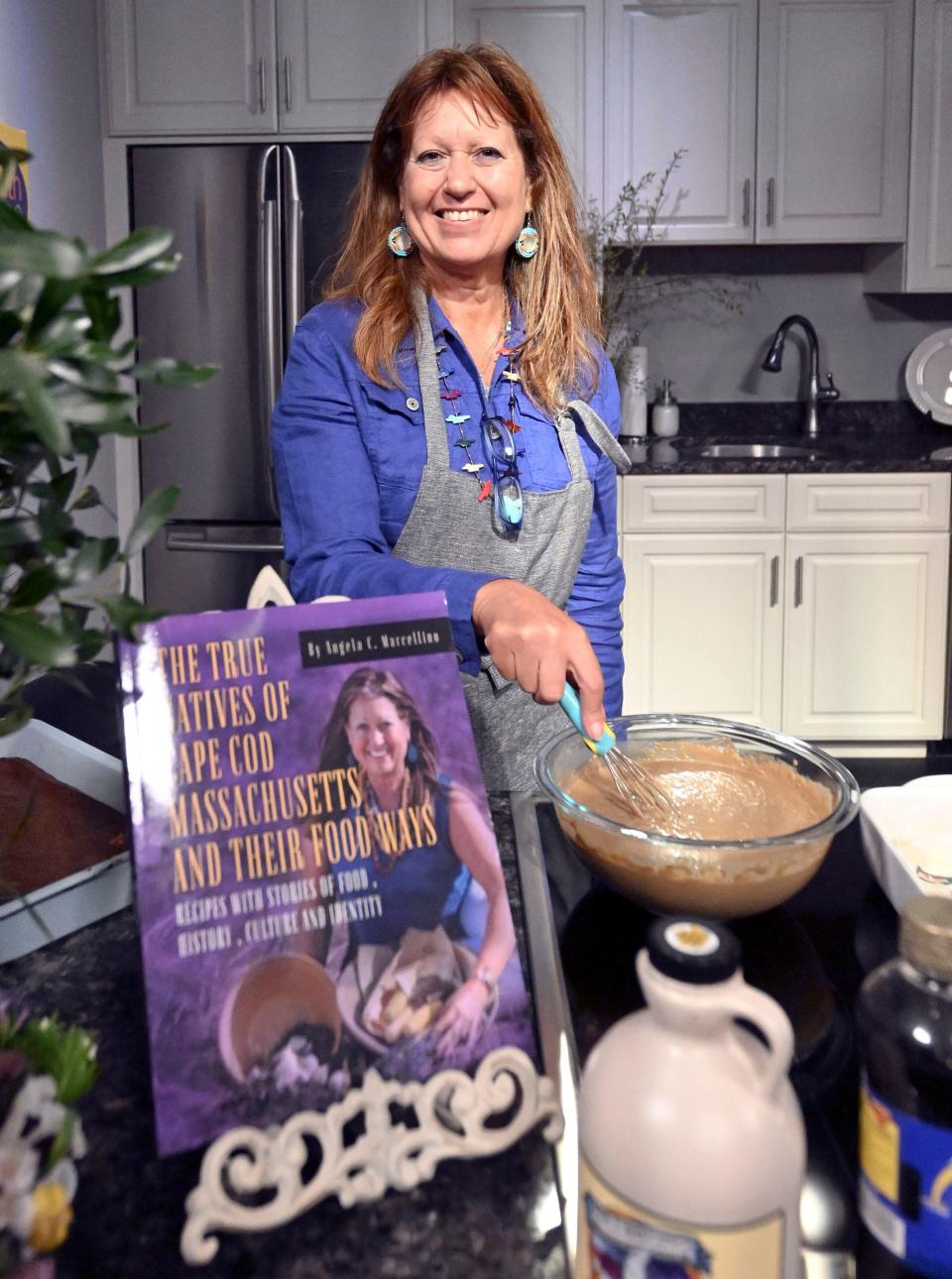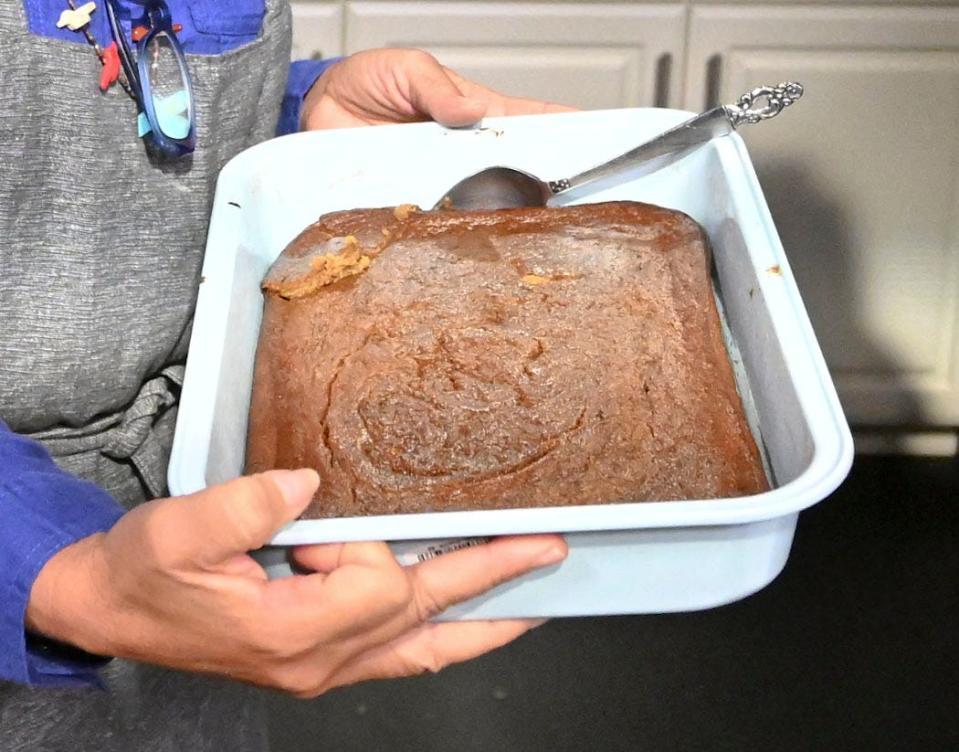What is real, traditional tribal food in Mashpee? Angela Marcellino explains
EDITOR'S NOTE: This story was edited on April 28, 2023, to correctly identify the island republic of Seychelles.
FALMOUTH — Bright studio lights at Falmouth Community Television illuminated Mashpee Wampanoag home chef Angela Marcellino as she cooked Indian pudding, along with Gail Blakely, host of "Falmouth is Cooking."
As the cameras rolled, Marcellino, author of "The True Natives of Cape Cod Massachusetts and their Food Ways," added refined, ground corn meal to her mixing bowl.
Corn, she told the audience, was cultivated by indigenous people, over the course of thousands of years. Seeds were agriculturally traded throughout the Americas by tribal communities. Wampanoag people, along with many tribal nations, bred corn to thrive within their own territories and created products like corn meal.

Corn meal, mixed with water, nuts, and dried berries, was often carried by Wampanoag runners who would make long journeys to visit other Native campsites, said Marcellino. They traveled to bring messages or find new hunting grounds. The cakes sustained runners for long periods of time.
"All things corn are very Native American and this special recipe (Indian pudding) is an example of Native American technology and research," she said.
Wampanoag dishes evolved to include ingredients from overseas.
Indian pudding, which also contains milk and cream in its modern form, also uses products brought to what is now known as America by English settlers, said Marcellino. The recipe, along with many others included in her 118-page book, tells the history of New England and the powerful contributions of Wampanoag people.
"Traditional Wampanoag dishes evolved to include resources shipped from overseas," she said. "Recipes came together through interactions between Wampanoag people and English settlers."
Marcellino's mother's quahog chowder was so good, tribal members would leave the shellfish on her doorstep.
Marcellino's book was released digitally and in paperback in January. It features recipes like oyster stew and roasted sunchokes — dishes taught to Marcellino by her mother Anne Peters Brown, and many other Wampanoag chefs like Bernadine and Sherry Pocknett, she said.
For Marcellino, the most sentimental recipe in the book is the quahog chowder. When Peters Brown, who died in October 2021, was living in Mashpee, she often came home to a bucket of quahogs waiting on her doorstep. It was typical, said Marcellino, for tribal members to leave the shellfish, in hopes that Peters Brown would make chowder.
"The sharing of the quahogs is linked to the ancient practice of living in a communal, sustainable, ancient society," said Marcellino.
Marcellino also recalls long afternoons as a child harvesting shellfish in Ockway Bay in Mashpee.
"Later in the day we prepped and shucked quahogs in the backyard with many of our friends and family sharing old stories about Mashpee," she said.

Community eating dates back 10,000 years for Wampanoag people.
Mashpee Wampanoag people still largely share food in the same way, she said. Community eating dates back 10,000 years for Wampanoag people, said Marcellino. Whether it's "Ancestors Day" or Powwow, traditional Wampanoag dishes are always at the table, she said.
"We don't put a dollar amount on it. It's part of our custom to make sure that everybody in our tribe survives and is nourished," she said.
Over time, much of Wampanoag heritage has been maintained through traditional cooking, said Marcellino.
"The quahog provided nourishment for ancient Wampanoag people and we cooked them on the beach in piles on open fires," she said. "It's such a versatile food and it tells the story of how we survived."
'The food tells the story of how this country started.'
In its modern version, chowder includes both indigenous and colonial ingredients, said Marcellino. Quahogs, potato, and wild onion reflect natural food ways of Native America, and salt back, or pork, along with milk and cream, are throwbacks to colonial agricultural practices of the 1600s.
"The interactions between Wampanoag people and settlers weren't always positive and we were forced to immerse in a lot of ways," she said. "But the food tells the story of how this country started."
Here's why you'll find a Cape Verdean recipe for jagacida in the book.
Beyond her Wampanoag roots, some of Marcellino's ancestors came from the island republic of Seychelles, and the Cabo Verde or Cape Verde Islands, off the coast of Africa. Her father John Marcellino, Jr. was Cape Verdean and spoke Creole fluently. In those times, said Marcellino, Cape Verdean people were taught to assimilate, so he often only spoke his native tongue to his mother.
But the food was carried down from one generation to the next. A recipe for jagacida or jag, as it's commonly known, is included in the book to weave in Marcellino's Portuguese and Cape Verdean culture. Her grandmother Lucile "Nana" Ramos Laport Marcellino, lived her entire life in Harwich, and later in Dennisport.
Described as having old world nuances, Nana often cooked vinegar pork chops and jag, said Marcellino. Composed of ingredients like rice, beans, bay leaf, and paprika, the taste of Nana's jag lingers in Marcellino's memory.
"I have not tasted anything as good as Nana's jag since she left us," said Marcellino. "It was nothing short of a miracle of goodness."
Marcellino found both her parents' surnames on whaling ship logs.
During her research, Marcellino also found both her parents' surnames on whaling ship logs preserved by the National Archives of Boston in Waltham, and the New Bedford Whaling Museum. Unions between Portuguese, Cape Verdean, and Wampanoag people were common because of the language and dialect, but also because of the deep-water practices of whaling, said Marcellino.
"Being whalers at one time was a dangerous (occupation) and can only be equated to being an astronaut in this day and age," she said. "You got on those ships, there was a high probability you weren’t coming home."
Cape Verde was colonized by Portugal in 1462, but gained independence July 5, 1975.
70% of the agricultural foods modern day Americans eat originate in the Americas.
Throughout the creation of her cookbook, Marcellino also researched a spectrum of old English cooking books and early Americana cookbooks.
"I did that to understand cooking techniques, and how those practices evolved in this country," she said.
From vegetables like the potato and squashes to grains like corn, Marcellino was shocked to learn that 70% of the agricultural foods modern day Americans eat originate in the Americas.
Throughout the book-writing process, Marcellino said she never noticed how connected modern-day Americans are to traditional English fare.
"You crawl into all these dark pubs where you find fried fish, bangers and mash, and chicken pot pies. It's all English food," she said. "It's a part of our culture."
Wampanoag responsibility to preserve the culture
Marcellino is the granddaughter of Steven Peters, a member of the Mashpee Wampanoag Tribe and a Mashpee selectman that served from 1927 to 1954.
While Marcellino didn't grow up in Mashpee until age 13, she quickly learned how tightknit the Wampanoag community is, she said. And as an adult, she followed in her grandfather's footsteps and served as a member of the Mashpee Wampanoag Economic Development Corporation Commission, the Mashpee Wampanoag Museum Committee and the Mashpee Wampanoag Housing Committee.
The book, she said, is an extension of the love she has for her tribal community.
"I was raised to protect our people," she said. "Our connection is so powerful – it’s 10,000 years old. We know each other so intimately."
For Marcellino, the cookbook is a vehicle that can help encourage conversations surrounding difficult moments between settlers and indigenous people throughout American history.
"Sometimes it's so difficult for non-Native people to talk about the many injustices that happened to indigenous people," she said. "It can be intimidating."
Instead, Marcellino hopes the book can steer discussions in a positive direction. In an upcoming appearance at noon, May 27 at Barnes & Noble in Hyannis, she said the Cape community can learn more about how to keep conversations ongoing.
"We all have our journey and we can discuss complex topics in a positive way and learn from one another," she said. Rachael Devaney writes about community and culture. Reach her at rdevaney@capecodonline.com. Follow her on Twitter: @RachaelDevaney.
Thanks to our subscribers, who help make this coverage possible. If you are not a subscriber, please consider supporting quality local journalism with a Cape Cod Times subscription. Here are our subscription plans.
This article originally appeared on Cape Cod Times: Cape author shows how to cook authentic Mashpee Wampanoag tribal food

